This site uses only a few technical cookies necessary for its operation. By continuing to browse, you accept their use.
To find out more...
To find out more...
New leavened bread
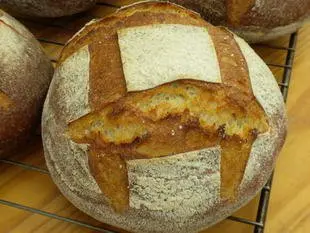
This new recipe for leavened bread is simple and delicious, but needs rather long resting times.
If you'd like more more information about making your own bread, look at this dedicated page.
If you'd like more more information about making your own bread, look at this dedicated page.
Last modified on: December 30th 2019
For 2 loaves, you will need:
- 1
 1 kg plain white flour (French Type 65)
1 kg plain white flour (French Type 65) - 2
 550 ml water
550 ml water - 3
 18 g fine (or table) salt
18 g fine (or table) salt - 4
 500 g leaven
500 g leaven - 5
 2 g yeast
2 g yeast - Total weight: 2,070 grams
Times for this recipe
Preparation: 50 min.
Resting: 5 hours 30 min.
Cooking: 40 min.
All in all: 7 hours
If you start now, at , you will finish around : ?.Change start time
To finish around 7pm, you'll need to have started before: .Change end time
Step by step recipe
Stage 1 - ⌛ 5 min.
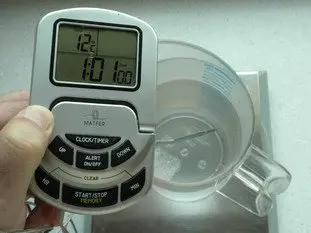
In bread-making, the water temperature is always important. It's not a fixed value, but related to 3 other temperatures: 1) the temperature of your flour, 2) the room temperature in your kitchen, and 3) the basic temperature of this recipe, which is 56-60°C.
You can calculate the temperature of the water for this recipe in one click, using this small calculator.
You can calculate the temperature of the water for this recipe in one click, using this small calculator.
Stage 2 - ⌛ 5 min.
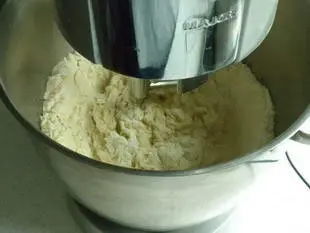
Put into the mixer bowl just 1 kg plain white flour (French Type 65) and 550 ml water at the right temperature.
Knead at minimum speed for 3 minutes.
Knead at minimum speed for 3 minutes.
Stage 3 - ⌛ 1 hour

Leave the dough in the mixer, cover with a plastic sheet, and leave to rest for 1 hour.
Stage 4 - ⌛ 3 min.
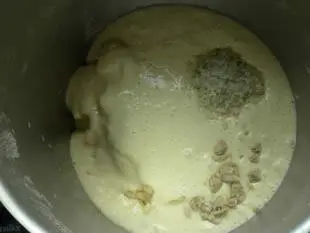
Stage 5 - ⌛ 10 min.
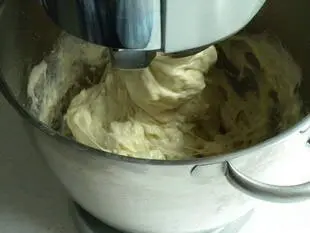
Knead at minimum speed for 10 minutes.
Note: For the best way to knead, see: A few tips for effective kneading at home.
Note: For the best way to knead, see: A few tips for effective kneading at home.
Stage 6
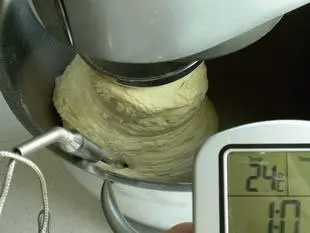
After kneading, you can check the temperature of the dough, which should be 75°F (24°C), or better try the window-pane test.
Stage 7 - ⌛ 3 min.

Turn the ugh out onto the worktop and gather into a rough ball.
Stage 8 - ⌛ 2 hours

Put the dough into a large floured bowl.
Cover with a plastic sheet, and leave to rest in a warm place for 1.5 to 2 hours.
Cover with a plastic sheet, and leave to rest in a warm place for 1.5 to 2 hours.
Stage 9 - ⌛ 3 min.
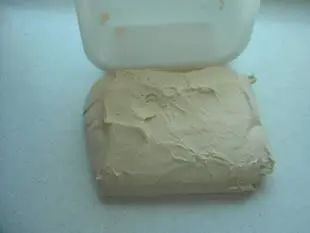
After resting, tip the dough onto your worktop.
Stage 10 - ⌛ 10 min.
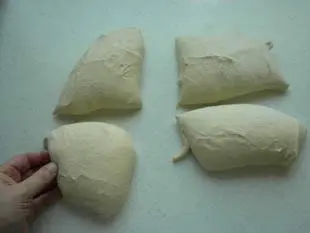
Divide into lumps of 500 grams (small loaves) or 1 kilo (large loaf).
Stage 11 - ⌛ 30 min.
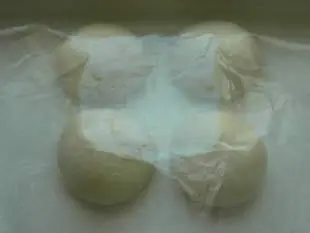
Shape each lump of dough into a ball, cover with a plastic sheet and leave to rest for 30 minutes.
Stage 12 - ⌛ 5 min.
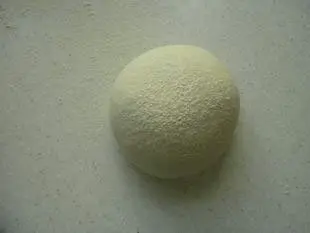
Press the dough flat again before shaping into round or long loaves.
Stage 13 - ⌛ 3 min.
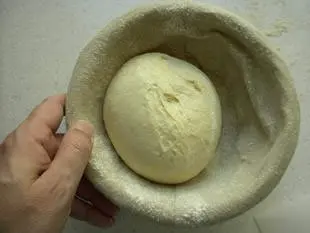
Put into floured bannetons (rising baskets).
Stage 14 - ⌛ 2 hours
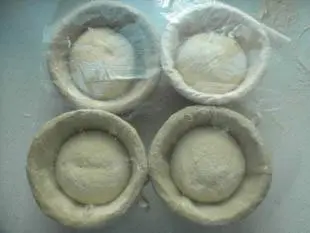
Cover with a plastic sheet and leave to rest for 2 hours.
Stage 15
As these actions are rather difficult to describe, you can watch this short demonstration video on the right.
Stage 16 - ⌛ 3 min.
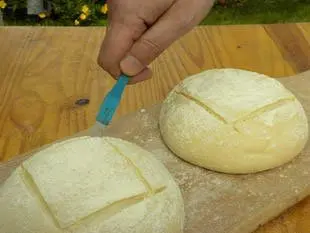
Preheat the oven to 240°C or 464°F.
Dust each loaf with flour, then turn it over onto the peel (bread oven "shovel") and slash it across the top.
Dust each loaf with flour, then turn it over onto the peel (bread oven "shovel") and slash it across the top.
Stage 17 - ⌛ 40 min.

Put in the for approximately 40 minutes (check near the end of cooking time).
Note: As when baking any bread, you should ensure that the oven is filled with steam for the first 15 minutes of baking. This page shows you how; it really is the secret of golden-brown, crusty loaves..
Note: As when baking any bread, you should ensure that the oven is filled with steam for the first 15 minutes of baking. This page shows you how; it really is the secret of golden-brown, crusty loaves..
Remarks
If you can, try a slow rising by replacing the last 2 hours of resting (stage 8) by 10 hours at 50°F (10°C).
If you'd like more information on making your own bread, you can consult this special page.
Many of you are puzzled by the presence of yeast in a leaven-raised bread. Here is a little clarification of the matter:
The yeast is there to make things easier; for a beginner leaven-raised bread is not easy to get right, especially first time. This is why these few added grams of yeast help. The dough rises more easily, even if your leaven is not at its best, and it makes a lighter crust.
There's nothing shocking in this. You should be aware that even some commercially produced breads advertised as "leavened", also contain a little (more) yeast, for similar reasons, and it's perfectly legal.
In any case, there's no reason to be worried about yeast; it's not a chemical product. It too is a living organism, and it's not added to work against the leaven, rather something you can use alongside if you wish. Being able to proclaim proudly, "I don't use any yeast!" is, in my humble opinion, rather overrated.
That said, adding a little yeast does have one slight drawback, in that it dulls the flavour of the bread somewhat. If you want to make leavened bread for its characteristic flavour, you'll lose a little, even with a small quantity of yeast.
In conclusion, I advise the following approach: if you are just starting out, add a little yeast. Then, once you have mastered the basics and can produce good bread, leave it out. You can then compare both methods and choose.
If you'd like more information on making your own bread, you can consult this special page.
Yeast in leaven-raised bread?
Many of you are puzzled by the presence of yeast in a leaven-raised bread. Here is a little clarification of the matter:
The yeast is there to make things easier; for a beginner leaven-raised bread is not easy to get right, especially first time. This is why these few added grams of yeast help. The dough rises more easily, even if your leaven is not at its best, and it makes a lighter crust.
There's nothing shocking in this. You should be aware that even some commercially produced breads advertised as "leavened", also contain a little (more) yeast, for similar reasons, and it's perfectly legal.
In any case, there's no reason to be worried about yeast; it's not a chemical product. It too is a living organism, and it's not added to work against the leaven, rather something you can use alongside if you wish. Being able to proclaim proudly, "I don't use any yeast!" is, in my humble opinion, rather overrated.
That said, adding a little yeast does have one slight drawback, in that it dulls the flavour of the bread somewhat. If you want to make leavened bread for its characteristic flavour, you'll lose a little, even with a small quantity of yeast.
In conclusion, I advise the following approach: if you are just starting out, add a little yeast. Then, once you have mastered the basics and can produce good bread, leave it out. You can then compare both methods and choose.
Keeping: Several days in a linen bag.
Source: From Thomas Marie of INBP.
Nutritional information
| Proteins (gr) | Carbohydrates (gr) | Fats (gr) | Energy value (in k-calories) | Energy value (in k-joules) | |
|---|---|---|---|---|---|
| Whole recipe | 170 RDI=70 % | 1,420 RDI=130 % | 30 RDI=4 % | 4,390 RDI=220 % | 18,390 RDI: 220 % |
| Per 100 g | 8 RDI=3 % | 70 RDI=6 % | 1 RDI=0 % | 210 RDI=10 % | 890 RDI: 10 % |
| Per loave | 90 RDI=30 % | 710 RDI=70 % | 10 RDI=2 % | 2,200 RDI=110 % | 9,190 RDI: 110 % |
How much will it cost?
- For 2 loaves : 2.30 €
- Per loave : 1.15 €
Change currency:
Note: Be careful, these prices are only an estimate, you can consult the table of prices by ingredients used for this estimate.
This recipe uses (among others)

Plain white flour (French Type 65)
Like these other recipes: Loaf for "les filles'", Bacon rolls, Ocean bread, Pizza dough, Benoîton, ... See them all 19

Water
Like these other recipes: Mint and chocolate cream, How to prepare endives , Seeded loaf, Langoustine sabayon tart, Grapefruit cake, ... See them all 139

Leaven
You can get more informations, or check-out other recipes which use it, for example: Benoîton, Sandwich bread, Saucipain, Ali Baba bread, Yeast-based flaky dough (for croissants), ... See them all 21

Fine (or table) salt
Like these other recipes: Rabbit terrine, Grated apple cake, Panzanella, Chocolate mousse, Viennese Shortbread, ... See them all 103
Other recipes you may also like
How to cook Morteau sausage well
This is, in my opinion, the best smoked sausage. You can cook it in a number of ways, here are three of the best known. November 15th 20182.82 M 23.4 40 min.
Breton galettes (pancakes)
Of uniquely Breton origin, this is a buckwheat pancake on which you cook an egg with ham and cheese before folding it over. Easy and quick to make, it's an ideal answer to the question "what are we going to eat this evening?". February 21th 2011231 K 23.9 20 min.
French croissants
In this famous and highly technical recipe from a piece of yeast-based flaky dough we are going to cut and shape ("roll") croissants. June 26th 2019652 K 24.4 2 hours 35 min.
Salmon rillettes
A terrine of two kinds of salmon (cooked and smoked) with butter and lemon. March 26th 2013299 K4.3 2 hours 40 min.
Soufflée omelette with cheese
Halfway between an omelette and a soufflé, this quick recipe give a light and delicious result. The secret is mainly in the two cooking methods: frying pan, then oven. June 22th 2013454 K4.7 55 min.
News list of cooking-ez.com
Sign up to receive the latest recipes (next batch due to be sent on 2026-01-04)
Note: We'll never share your e-mail address with anyone else.
Follow this recipe (as 10 people already do)
If you are interested in this recipe, you can "follow" it, by entering your email address here. You will then receive a notification immediately each time the recipe is modified or a new comment is added. Please note that you will need to confirm this following.
Note: We'll never share your e-mail address with anyone else.
Alternatively: you can subscribe to the mailing list of cooling-ez.com , you will receive a e-mail for each new recipe published on the site.





The 3 comments already posted on this recipe
I have just finished a deep improve of the recipe, more simple, more tasty, I'm sure you'll enjoy it!